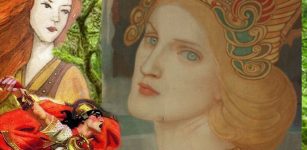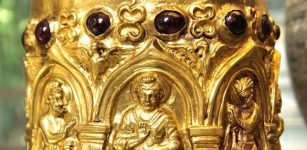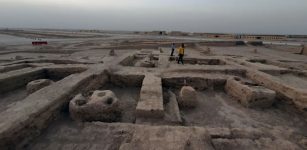Mystery Of Vitrified Scottish Fort Dun Deardail And Ancient Myth Deirdre Of The Sorrows: Is There A Prehistoric Connection?
Ellen Lloyd - AncientPages.com - Standing on a spectacular hilltop in Glen Nevis, to the west of Ben Nevis, we find Dun Deardail, a mysterious, ancient vitrified Scottish fort.
Why Fort Dun Deardail was built, who built it, and when it was constructed remains an ancient mystery, but some have suggested the answers can be found in an ancient myth called the Deirdre of the Sorrows.
Why was Dun Deardail destroyed?
Sometimes, ancient myths and legends can cast more light on mysterious buildings, places, and lost prehistoric civilizations. Can the myth Deirdre Of The Sorrows unravel the ancient mystery of Dun Deardail?
Why Is Dun Deardail Vitrified?
The age and purpose of Dun Deardail are unknown, but scientists think it was probably built in the first millennium BC, although it may have been occupied and reused on several occasions through time.
The fort is vitrified, which means that its wooden and stone defenses were burned at such high temperatures and for such a long time that the stone fused together.
The fort was built on a knoll among the mountains of Glen Nevis. Image credit: Nevis Landscape Partnership
There are many vitrified forts across Scotland, and scientists have long speculated about the cause of vitrification. It was previously thought the process was either unintentional or resulted from an accident or attack. However, experimental archaeology has shown that vitrification occurs only after long burning periods: the fires must have been fed and stoked, suggesting that vitrification was an intentional process.
Very little is known about Dun Deardail because scientists have properly investigated the vitrified fort. The first archaeological expedition started in 2015 when Nevis Landscape Partnership broke new ground at Dun Deardail. A team of volunteers conducted the first excavations of this enigmatic site with the support of AOC Archaeology Group (AOC) archaeologists.
The partnership was a five-year £3.9m scheme consisting of 19 projects, and hopefully, soon, we will learn about some of the ancient secrets Dun Deardail has kept hidden for many years.
Why Dun Deardail is vitrified is unknown, but according to Forestry Commission Scotland archaeologist Matt Ritchie, there were many probable causes for the fire at Dun Deardail, including its Iron Age residents ritualistically setting the structure ablaze.
A reconstruction of what the hill fort looked like when the fire broke out at the site, caused the vitrification of its rock defenses. Image credit: Chris Mitchell (fair use)
"It could be anything from an accidental fire to deliberate destruction.
Perhaps at the death of the tribal chief or king, they burned the hill fort in the same way the Vikings may have burned the longboats of a chief, or it is deliberate destruction during warfare,” Matt Ritchie said.
The Ancient Irish Myth Of Deirdre Of The Sorrows
It has also been suggested that the name of Lochaber's hill fort may be linked with an ancient Irish myth called Deirdre of the Sorrows. It is a tragic tale of the beautiful Deirdre, and the myth has been told for over 2,000 years.
Deirdre of the Sorrows is part of the Ulster Cycle of Irish Myths. It is the last of 'The Three Sorrowful Tales of Erin'.
The legend tells that before Deirdre was born, the chief druid Cathbad foretold that her incredible beauty would lead kings, lords, and warriors to fight and die for her love, trying to win her hand in marriage.
Deirdre’s father was Fedlimid Mac Daill, the royal storyteller who told wonderful tales at the court of Conchobar mac Nessa, King of Ulster.
When King Conchobar learned of the druid’s prophesy, he decided to have Deirdre raised in seclusion.
Helen Stratton - A book of myths (1915) New York: G. P. Putnam's sons; London, T. C. & E. C. Jack. Copy at New York Public Library.
As time passed, Deirdre grew into a beautiful young woman the druid Cathbad's prophesy began to come true. Kings, noble warriors, and lords battled, bled, and died for the beautiful Deirdre.
King Conchobar had no intention of letting Deirdre go and planned to marry her when she was older. Deidre was brought up in isolation by Leabharcham, a poet and wise woman. As a young girl living isolated in the woodlands, Deirdre, one snowy day, told Leabharcham that she would love a man with the colors she had seen when a raven landed in the snow with its prey: hair the color of the raven, skin as white as snow, and cheeks as red as blood.
Leabharcham told her she was describing Naoise, a handsome young warrior, hunter, and singer at Conchobar's court. When Deidre and Naoise met one day, they fell in love and accompanied by Naoise’s brothers Ardan and Ainnlethey fled to Scotland, where they lived a happy life.
But the furious, humiliated King Conchobar tracked them down and sent Fergus mac Róich to them with an invitation to return and Fergus's own promise of safe conduct home, but on the way back to Emain Macha Conchobar had Fergus waylaid, forced by his personal geis (an obligation) to accept an invitation to a feast.
Fergus sent Deirdre and the sons of Uisnech on to Emain Macha with his son to protect them. When they arrived, Conchobar sent Leabharcham to spy on Deirdre to see if she had lost her beauty.
Leabharcham wanted to protect Deirdre. She lied and told the king that Deirdre was now ugly and aged. Unfortunately, King was not convinced, and he sent another spy, Gelbann, who managed to catch a glimpse of Deirdre but was seen by Naoise, who threw a gold chess piece at him and put out his eye.
The spy managed to get back to Conchobar and told him that Deirdre was as beautiful as ever. Conchobar called his warriors to attack the Red Branch house where Deirdre and the sons of Uisnech were lodging. Naoise and his brothers fought valiantly, aided by a few Red Branch warriors, before Conchobar evoked their oath of loyalty to him and had Deirdre dragged to his side. At this point, Éogan mac Durthacht threw a spear, killing Naoise, and his brothers were killed shortly after.
Fergus and his men arrived after the battle. Fergus was outraged by this betrayal of his word and went into exile in Connacht. He later fought against Ulster for Ailill and Medb in the war of the Táin Bó Cúailnge (the Cattle Raid of Cooley), the Irish Iliad.
After the death of Naoise, Conchobar took Deirdre as his wife. As we all know, love cannot be bought or forced. After a year, angered by Deirdre's continuing coldness toward him, Conchobar asked her whom in the world she hated the most, besides himself. She answered, "Éogan mac Durthacht," the man who had murdered Naoise. Conchobar said that he would give her to Éogan. As she was being taken to Éogan, Conchobar taunted her, saying she looked like an ewe between two rams. At this, Deirdre threw herself from the chariot, dashing her head to pieces against a rock.
Is it possible the battles took place at the fort of Dun Deardail? When archaeologists excavate the site, will they then find the skeletons of the ancient kings, warriors, and lords who battled to win Deirdre’s heart? Will they find the ancient skeleton of Naoise and his brothers?
We don’t know, but maybe time and future archaeological excavations will help find an answer to these intriguing questions.
Written by Ellen Lloyd – AncientPages.com
Updated on November 11, 2024
Copyright © AncientPages.com All rights reserved. This material may not be published, broadcast, rewritten or redistributed in whole or part without the express written permission of AncientPages.com
More From Ancient Pages
-
 Ancient Romans Used The Poisonous Black Henbane Plant As Hallucinogenic Medicine
Archaeology | Feb 9, 2024
Ancient Romans Used The Poisonous Black Henbane Plant As Hallucinogenic Medicine
Archaeology | Feb 9, 2024 -
 Ostracism: Political Practice In Ancient Athens
Ancient History Facts | May 7, 2019
Ostracism: Political Practice In Ancient Athens
Ancient History Facts | May 7, 2019 -
 Baby Carriers Were Used 10,000 Years Ago – New Evidence
Archaeology | Sep 27, 2022
Baby Carriers Were Used 10,000 Years Ago – New Evidence
Archaeology | Sep 27, 2022 -
 Mystery Of The Ancient Moonless Ones – Strange Tales Of Unusual Lost Civilizations
Ancient Mysteries | Jan 29, 2022
Mystery Of The Ancient Moonless Ones – Strange Tales Of Unusual Lost Civilizations
Ancient Mysteries | Jan 29, 2022 -
 Ancient Human Traces Found In The Inhospitable Namib Desert
Human Beginnings | Oct 21, 2024
Ancient Human Traces Found In The Inhospitable Namib Desert
Human Beginnings | Oct 21, 2024 -
 Never-Before-Seen Structures Of King Herod’s Magnificent Palace Herodium Unveiled
Archaeology | Dec 11, 2020
Never-Before-Seen Structures Of King Herod’s Magnificent Palace Herodium Unveiled
Archaeology | Dec 11, 2020 -
 Haryana Caves In Mangar Bani Hide An Ancient Secret – Are These The Oldest Cave Paintings In India?
Archaeology | Jul 28, 2021
Haryana Caves In Mangar Bani Hide An Ancient Secret – Are These The Oldest Cave Paintings In India?
Archaeology | Jul 28, 2021 -
 Ancient Mysteries Of Chicago: Is The Puzzling Waubansee Stone A Neglected Pre-Columbian Artifact?
Artifacts | Mar 4, 2017
Ancient Mysteries Of Chicago: Is The Puzzling Waubansee Stone A Neglected Pre-Columbian Artifact?
Artifacts | Mar 4, 2017 -
 Aoife: Beautiful Female Warrior, Lover Of Cuchulainn And Mother Of His Only Son In Irish Beliefs
Celtic Mythology | Mar 18, 2019
Aoife: Beautiful Female Warrior, Lover Of Cuchulainn And Mother Of His Only Son In Irish Beliefs
Celtic Mythology | Mar 18, 2019 -
 The Bimaran Casket – Rare Golden Artifact Found In Ancient Stupa
Artifacts | Dec 17, 2018
The Bimaran Casket – Rare Golden Artifact Found In Ancient Stupa
Artifacts | Dec 17, 2018 -
 Rock Stars: How A Group Of Scientists In South Africa Rescued A Rare 500 Kg Chunk Of Human History
Featured Stories | Oct 20, 2022
Rock Stars: How A Group Of Scientists In South Africa Rescued A Rare 500 Kg Chunk Of Human History
Featured Stories | Oct 20, 2022 -
 On This Day In History: Battle Of Las Navas De Tolosa Was Fought – On July 16, 1212
News | Jul 16, 2016
On This Day In History: Battle Of Las Navas De Tolosa Was Fought – On July 16, 1212
News | Jul 16, 2016 -
 Assyrian King Ashurbanipal’s Great Library With Thousands Of Cuneiform Tablets
Civilizations | Dec 9, 2015
Assyrian King Ashurbanipal’s Great Library With Thousands Of Cuneiform Tablets
Civilizations | Dec 9, 2015 -
 On This Day In History: Adventurer Thor Heyerdahl And His Kon-Tiki Reached French Polynesia – On August 7, 1947
News | Aug 7, 2016
On This Day In History: Adventurer Thor Heyerdahl And His Kon-Tiki Reached French Polynesia – On August 7, 1947
News | Aug 7, 2016 -
 Biblical City Of Tarsus: Excavations Reveal Its Secrets From Paul the Apostle’s Times
Archaeology | Jan 4, 2016
Biblical City Of Tarsus: Excavations Reveal Its Secrets From Paul the Apostle’s Times
Archaeology | Jan 4, 2016 -
 A 3,500-Year-Old Grape Seed Sheds Light On Great Tradition Of Vineyards Of Anatolia’s Çal And Region
Archaeology | Sep 13, 2023
A 3,500-Year-Old Grape Seed Sheds Light On Great Tradition Of Vineyards Of Anatolia’s Çal And Region
Archaeology | Sep 13, 2023 -
 Ancient Parthian City With Hundreds Of Artifacts Unearthed In Iraq
Archaeology | Aug 16, 2022
Ancient Parthian City With Hundreds Of Artifacts Unearthed In Iraq
Archaeology | Aug 16, 2022 -
 Sacred Regalia Of Japanese Emperor: Sword, Mirror And Jewel In Ancient Japanese Tradition
Artifacts | Sep 2, 2017
Sacred Regalia Of Japanese Emperor: Sword, Mirror And Jewel In Ancient Japanese Tradition
Artifacts | Sep 2, 2017 -
 Abu Erteila’s Lost Temple And The Meroitic Empire: New Discoveries Shed Light On Nubian Civilization
Archaeology | Jan 14, 2016
Abu Erteila’s Lost Temple And The Meroitic Empire: New Discoveries Shed Light On Nubian Civilization
Archaeology | Jan 14, 2016 -
 Large Roman Public Latrine With 60 Wooden Seats Discovered In Bet Shean, Israel
Archaeology | Sep 25, 2023
Large Roman Public Latrine With 60 Wooden Seats Discovered In Bet Shean, Israel
Archaeology | Sep 25, 2023




